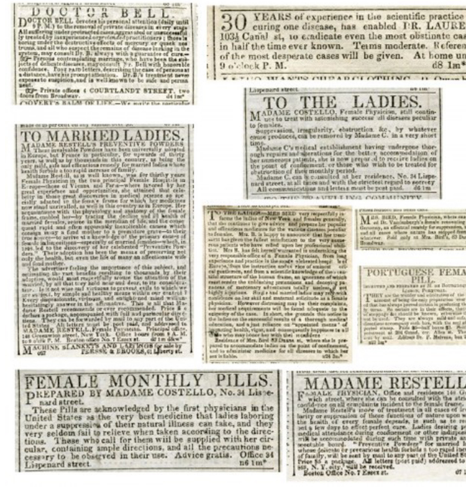The 1821 Abortion Law of Connecticut is known as the first legal action that was passed to restrict reproductive rights of American women.
The law prevented women from receiving or attempting abortions, generally through consuming poison, during the first fourth months on pregnancy. (“The First U.S. Abortion Law – est. 1821.”, 1)[1]
During this time period, unwanted pregnancies were on the rise, as women had little knowledge of birth control or how to properly prevent pregnancy.(“The First U.S. Abortion Law – est. 1821.”, 1)[2] This was because there was a lack of circulation of knowledge, really, therefor leaving women clueless and vulnerable when is came to sexual health and education.
To have a law placed on a form of contraception created an even further divide between women and men, leaving men with power to control and women with no choice but to comply. Law was law, and unless followed, punishment was inevitable.
Although the 1821 Abortion Law of Connecticut didn’t outlaw abortions completely, it did place heavier restrictions on the women’s reproductive market. It did make it harder for women to control their bodies.(“The First U.S. Abortion Law – est. 1821.”, 1)[3] It did push women’s rights back further. It made it harder for women’s doctors to provide services they needed, creating issues in the courts and with local officials if services continued.
This law ignited a domino effect throughout America, as many states jumped the band wagon, following Connecticut. (“The First U.S. Abortion Law – est. 1821.”, 1)[4]
This also was part of the reason why back-alley abortions became popular. Yes, the amount of legislation against abortion rose, but the amount of abortions being carried out did not decline in response. Many, many women died after having illegal, black market abortions with untrained “doctors” in unsanitary places. (“History of Abortion – National Abortion Federation.”, 1)[5]
 (http://www.elle.com/life-love/a14570/abortion-in-the-19th-century/)
(http://www.elle.com/life-love/a14570/abortion-in-the-19th-century/)
When looking at sources like this, it’s easy to see what resources were available before the domino effect of the 1821 Connecticut Law. Advertisements were in the newspaper about monthly pills, and Madame Restell’s women’s sexual health services. Once the law placed restrictions on women’s reproductive services, the restrictions continued to grow. (Manning, 1)[6]
[1] Joannamikel1. “The First U.S. Abortion Law – est. 1821.”, 1
[2] Joannamikel1. “The First U.S. Abortion Law – est. 1821.”, 1
[3] Joannamikel1. “The First U.S. Abortion Law – est. 1821.”, 1
[4] Joannamikel1. “The First U.S. Abortion Law – est. 1821.”, 1
[5] “History of Abortion – National Abortion Federation.” National Abortion Federation., 1
[6] Manning, Kate. “What Abortion Was Like in the 19th Century.”, 1
Sources:
Joannamikel1. “The First U.S. Abortion Law – est. 1821.” A History: U.S. Abortion Legalities. N.p., 08 Oct. 2014. Web. 12 Feb. 2017.
“History of Abortion – National Abortion Federation.” National Abortion Federation. N.p., n.d. Web. 12 Feb. 2017.
Manning, Kate. “What Abortion Was Like in the 19th Century.” ELLE. N.p., 22 Oct. 2014. Web. 12 Feb. 2017.
Primary:
(the picture is the primary resource)
Manning, Kate. “What Abortion Was Like in the 19th Century.” ELLE. N.p., 30 Aug. 2016. Web. 12 Feb. 2017.
